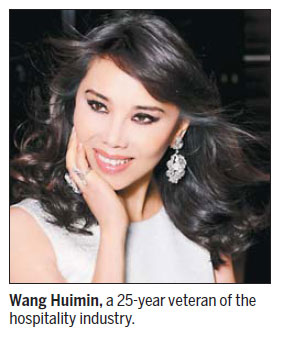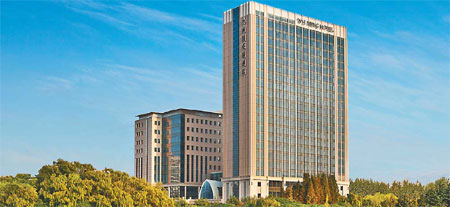Urban sanctuary
Updated: 2012-10-13 08:10
By Zhu Yile (China Daily)
|
|||||||||||
|
WHM Group, known for its upscale Chinese restaurants, is expanding into the hotel sector. Photos Provided to China Daily |
Amid lush greenery, the WH Ming Hotel delivers authentic Shanghainese hospitality in a refined modern setting. Zhu Yile reports.
The Shanghai-based WHM Group, known for its upscale Chinese restaurants, is expanding into the hotel sector with an exclusive five-star property on the Northeast Bund. The 188-room WH Ming hotel, named for the pinyin abbreviation of company founder Wang Huimin's name, aims to create an authentic Shanghai hospitality experience enriched with a contemporary flair.
 |
Billed as an "urban hideaway", the WH Ming stands on a sprawling 600,000-square-meter lot, a stone's throw from Huangxing Park. The hotel is designed to appeal to the senses of busy travelers and city residents looking for sanctuary in the heart of Shanghai, says Wang, a 25-year veteran of the hospitality industry.
With most five-star hotels managed by American or European companies, Wang sought with the WH Ming Hotel to create a homegrown luxury hospitality experience.
"I want to show the world that China can do it, too," she says.
"With Frank Rudis, who has rich hotel management experience and can effectively implement my vision, as general manager, the WH Ming offers the very best of East and West."
Rudis says: "Given Wang Huimin's deep understanding of the local market, I am optimistic about this distinctly Chinese luxury hotel."
At the core of the WH Ming experience is the concept of "one night, two meals", which emerged in Asia during the 1990s and encompasses a delicious dinner, revitalizing sleep and exceptional breakfast.
"It helps city dwellers recharge," says Wang. "Once they feel refreshed, they are glad to return to their fast-paced urban lifestyles."
WH Ming, she says, has re-imagined the concept for contemporary Shanghai, featuring the city's eminent cuisine and serving it both in the hotel restaurant and on request in the rooms of guests.
Guests can enjoy spa service at the hotel's Faye Spa Center. The 5,000-sq-m space covers three floors and includes 22 private spa suites equipped with a Jacuzzi.
"We have created a spa experience that can be shared in a more communal space or experienced completely in private," Wang says.
Long known for its rich restaurant portfolio, including Shanghai Min and Maison de L'Hui, WHM Group has incorporated that culinary experience into the hotel's fine selection of breakfast foods.
"It is normal that people have a deep attachment to the food their mothers cooked for them when they were children. The hotel aims to bring that warm feeling of mom's home cooking to guests," she says.
Meanwhile, interaction between the chef and guests makes for a lively atmosphere.
One of the most unique aspects of the WH Ming Hotel is its "time tunnel", a mini-museum divided into different sections representing Shanghai's history from the Qing Dynasty until present-day. 3D video presentations on the walls depict scenes from each of the periods.
Dubbed the Media Image Art Space, the time tunnel was created by Shanghai-born Chinese-American director Hu Xueyan in collaboration with Wang.
The time-travel adventure illustrates the hotel's innovative approach to luxury hospitality, says Wang.
"The tunnel is designed so that guests can eat food from the respective periods as they watch the video, to experience the culinary evolution of Shanghai," she says.
At the end of the time tunnel is a green space filled with luxuriant plants representing a bright future. A special massage chair in this section is available to guests who wish to unwind.
"It is a wonderful way to relax at the end of the journey," says Wang.
Contact the writer at zhuyile@chinadaily.com.cn.
Today's Top News
President Xi confident in recovery from quake
H7N9 update: 104 cases, 21 deaths
Telecom workers restore links
Coal mine blast kills 18 in Jilin
Intl scholarship puts China on the map
More bird flu patients discharged
Gold loses sheen, but still a safe bet
US 'turns blind eye to human rights'
Hot Topics
Lunar probe , China growth forecasts, Emission rules get tougher, China seen through 'colored lens', International board,
Editor's Picks

|

|

|

|

|

|






